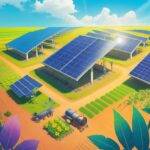
Imagine for a moment a world where farms in the countryside are not just stretches of crops but also vast power plants that generate clean energy. This isn’t a scene from a science fiction novel but a reality that is taking shape in the fields of agrivoltaics — a cutting-edge blend of agriculture and photovoltaic solar power.
In the heart of agrivoltaics, we find a delicate dance between solar panels and crops, sharing the sunlight to grow food and generate electricity. But for this dance to be graceful and efficient, the movement of solar panels must be precisely choreographed. Here, we delve into the realm of “customized tracking” (CT), a technology that could revolutionize how we harness the sun’s energy across the changing seasons while keeping our fields green.
The Basics of Agrivoltaics
Agrivoltaics is the co-location of solar photovoltaic panels and agriculture on the same land. It’s an ingenious solution that maximizes land use by producing energy and food simultaneously. But it comes with a challenge: how to ensure that both the solar panels and crops get enough sunlight to thrive?
The answer lies in the art of positioning and movement. Fixed solar panels are at a disadvantage because once they are installed, they can’t be moved to adapt to the changing needs of the crops below. This is where CT comes in — a system that moves the panels to follow the sun’s path across the sky.
The Intricacies of Customized Tracking
Customized tracking is not just about blindly following the sun; it’s about striking the perfect balance between light and shade. For example, certain crops may need more shade, so the panels need to tilt to provide that. This delicate balance is influenced by several factors, including the type of crops, the layout of the solar panel arrays, and even local socio-economic conditions.
A case study in Punjab, Pakistan, reveals that moderate shade-loving crops under dense arrays of solar panels may need a 30–40% increase in energy prices to achieve 80% of the food-energy yield. In simpler terms, the farmers and energy companies need to work together to find a price that makes this system economically viable.
The Techno-Economic Model
To navigate this complex web of agrivoltaics, researchers have developed a techno-economic model. This model helps us understand the cost of the solar panel systems and the financial return from both the energy produced and the crops grown. It’s like a guidebook for designing agrivoltaic systems that are as profitable as they are sustainable.
The Role of Customized Tracking
Customized tracking allows for what is known as “anti-tracking” around sunrise and sunset. This means that the panels can move against the sun’s path when necessary to give crops the early morning or late evening light they need. The CT systems can be adjusted to ensure that the crops get enough sunlight during critical growth periods while still producing ample solar power.
The Economic Implications
The cost of implementing CT in agrivoltaic systems is not trivial. The investment needs to be balanced against the increased income from crop yields and energy production. The techno-economic model takes into account factors like the cost of solar panel systems, the prices paid for the electricity generated (feed-in tariff), and the income from the crops.
The Balancing Act
One of the most crucial aspects of CT is finding the optimal balance between energy generation and crop yield. The model helps to identify the best strategies to maximize both, which could mean adjusting how much the panels track the sun. It’s a complex equation that considers the unique needs of each farm and crop type.
The Visual Guide
To help you understand how CT works and its benefits, let’s visualize the concept with a detailed graph below. This line graph below compares the cumulative performance benefits over time for high-value and low-value crops, each receiving a hypothetical increase in Feed-in Tariff (FIT).

- The blue line represents high-value crops, showcasing a steeper increase in cumulative performance benefits over a 10-year period, assuming a 20% FIT increase.
- The orange dashed line represents low-value crops, with a more gradual increase in benefits over the same period, assuming a 10% FIT increase.
The Future of Agrivoltaics
Agrivoltaics with CT is a promising step toward a future where farms can feed the population and contribute to energy production without competing for land. By optimizing the use of sunlight, we can take a significant leap towards sustainability and energy independence.
In Conclusion
The research into agrivoltaics and CT is not just about farming or energy production; it’s about reimagining how we live in harmony with our environment. It’s a testament to human innovation and our relentless pursuit of solutions that benefit both our planet and its inhabitants.
About Disruptive Concepts
Welcome to @Disruptive Concepts — your crystal ball into the future of technology. 🚀 Subscribe for new insight videos every Saturday!







